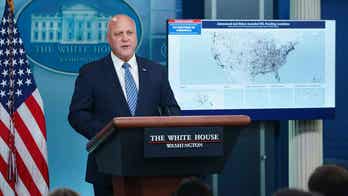BIRMINGHAM, Ala. – Leaders of Alabama's most populous county on Wednesday voted to declare an estimated $4.1 billion bankruptcy, the largest for a municipality in U.S. history.
Two months after it seemed Jefferson County had struck a deal to settle the debt, the commissioners took the action. It came after spending about six hours over two days meeting with its lawyers to discuss legal options. Those options included a Chapter 9 bankruptcy filing and a settlement with creditors on the county's $3.14 billion sewer debt.
Jefferson County has been trying since 2008 to avoid filing bankruptcy over the debt, which resulted from a mix of outdated sewer pipes, the lagging economy, court rulings and public corruption. At the same time, it faces a separate shortfall of as much as $50 million in its operating budget because courts struck down a major local tax as unconstitutional.
Commissioner Jimmie Stephens made the motion to file for bankruptcy. He said the commission and creditors never could complete the tentative agreement they reached in September and remained about $140 million apart.
"Despite our best efforts the negotiations had not produced any decision that fairly treats the county and our citizens. And it did not appear that further negotiations would produce that," he said.
The September agreement called for $1 billion in concessions from creditors and sewer rate increases of up to 8.2 percent a year. He said that without more concessions, the rates would have had to be above 8.2 percent.
He said filing the largest municipal bankruptcy ever will create an initial shock, but it will be good to start resolving a financial problem that has hindered the county for too long.
"Jefferson County has, in effect, been in bankruptcy for three years," he said.
The vote comes just two months after a preliminary deal was struck with Wall Street bankers that would have allowed the county to avoid the embarrassment of filing the largest municipal bankruptcy in the U.S. However, despite the deal providing a hopeful sign, there was still a possibility that bankruptcy would be necessary.
The deal was to have required state lawmakers to approve a mix of local tax hikes, budget changes and other legislation to resolve the billions in debt.
Jefferson County has about 658,000 residents and is home to both Alabama's largest city, Birmingham, and its medical and financial centers.
The settlement proposal with Wall Street investors led by JPMorgan Chase & Co included the lenders agreeing to forgive about $1 billion in debt, the county refinancing about $2 billion, and the a series of sewer rate increases.
If Jefferson County follows through in filing for bankruptcy, it would overshadow the one filed by record-holder Orange County, Calif., in 1994 over debts totaling $1.7 billion.
Pennsylvania's capital city of Harrisburg recently sought bankruptcy protection under similar circumstances as it struggled with about $300 million in debt from a trash incinerator that began operating in 1972.
A federal court forced Jefferson County to begin a huge upgrade of its outdated and overwhelmed sewer system to meet federal clean-water standards in the 1990s, and officials used bonds to finance the improvements. Outside advisers suggested a series of complex deals with variable-rate interest that were later shown to be laced with bribes and influence-peddling.
Loan payments rose quickly because of increasing interest rates as global credit markets struggled, and the county could no longer afford its payments. Meanwhile, a string of elected officials, public employees and business people were convicted of rigging the transactions that helped put the county in so much trouble.
Those convicted in the graft investigation include then-Birmingham Mayor Larry Langford, a former president of the Jefferson County Commission; and ex-Commissioner Chris McNair, whose daughter was one of the four black girls killed in an infamous Ku Klux Klan church bombing in Birmingham in 1963. Langford and McNair both are in federal prison.




